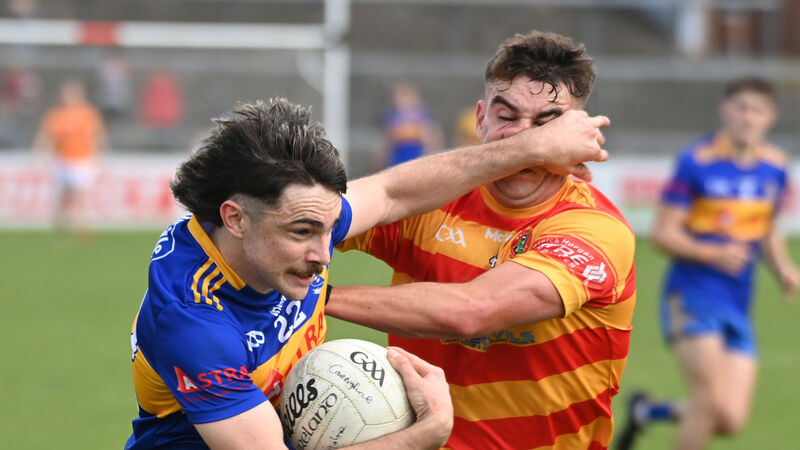Christy O'Connor: New rules voted in but there's still too many long passages of possession football

Carrigaline's Kevin O'Reilly holds off Newcestown's Paul Kelly during the McCarthy Insurance Group Cork Premier SFC quarter-final at Páirc Uí Rinn. A highly entertaing game, it went all the way to penalties before Newcestown prevailed Picture: Eddie O'Hare
Long before Saturday’s Special Congress in Croke Park, the Football Review Committee outlined the benefits of the new rules in a blizzard of numbers and figures, the final report supporting the perception that Gaelic football was now operating in a whole new world.
Is it? The data aims to support that perception. The figures show how there had been a 45% increase in goal attempts (from 4.2 to 6.1 per game) and a 16 per cent rise in overall scores compared to the 2024 season. And yet, there had only been a 5% increase in goals scored, and a 12% rise in shots per game.
Such a small increase in goals doesn’t seem like a whole lot to be shouting about – especially when there was a 45% increase in goal attempts. Yet productivity is sure to rise once players and coaches figure out better ways to translate those chances into a more profitable return.
On the other hand, coaches are always on the lookout for more than just ways to keep the scoreboard moving. Especially now that they have been exposed to that new world for a full year.
“It was suck it and see for a lot of last season,” said Wicklow manager Oisin McConville recently. “This time around, we have a bit more time to plan. Having spoken to a few other guys at inter-county level, they have a few ideas about how to try and control the game more next year.”
Control is one of the favourite words of a manager and a coach, but that’s been harder to implement since the new rules have created the potential for more chaos, which has also taken away the ability of opposition coaches and players to try and control that disorder.
Teams have more time now to practise scenarios to try and halt the opposition’s momentum with set-plays. Still, it’s hard to fully replicate that environment in a red-hot championship setting. And when momentum shifts, panic can easily set in.
In the modern environment, everything is analysed. Coaches will look everywhere for an edge. And some of those findings will be found deep within the data.
Teams use analytics for their own advantage but the overall collection of data around Gaelic football has gone to a whole different level since the Games Intelligence Unit (GIU) was established earlier this year.
The primary function of the body was to assist the FRC as they continued to monitor the impact of the new rules. However, the figures the GIU have constantly collated has also had huge benefits for all teams and coaches, as well as referees and the media.
Most teams now have excellent performance analysts on board. GAA analysts are always willing to share material because they all appreciate how tedious the practise of collating and coding can be.
Individualising information or footage, or trying to trace opposition patterns or trends, is a far more private exercise but every team benefits from the coded data that the GIU provide to intercounty teams on a weekly basis. Some of that info can be even more beneficial again to teams with fewer resources, especially in trying to understand game patterns and trends.
The move to enhance data informed policy making was first outlined in the GAA’s Aontus Strategic Plan 2022-26. The establishment of the GIU was set in motion at Special Congress in November 2024.
The initial outputs were statistic based but presenting data on average game characteristics before and after the implementation of rule enhancements provided huge insights into how football was evolving throughout the season.
Having partnered with the School of Health & Human Performance and the Insight Centre for Data Analytics at Dublin City University (DCU), the data gathered was also released periodically as overall and average metrics, all of which providing fascinating insights into how different Gaelic football now is.
There is no doubting that the game is far better now than it was. But how much better is it? The FRC clearly felt that restrictions imposed around the handpass at inter-county level could see the game descend into more chaos than they would like.
Gaelic football is still searching for that right balance but one of the challenges the game will always face is how some coaches try and skew the rules in order for them to be able to exert more control.
For too long football was reacting those challenges but there is far less scope now than there was in the past for coaches to hijack the game for their, and their team’s benefit.
Having more data and information at hand does help to police and protect the game more from rogue patterns and trends, which was another reason why it was so important for the GIU to continue to operate beyond 2025.
The GIU has now been placed on a permanent footing to gather and collate data to assist in the evaluation of the rule changes. Yet the GIU has a lot more to offer Gaelic football going forward than just monitoring those rule changes.









 App?
App?







